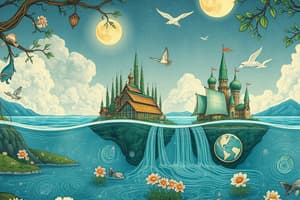Podcast
Questions and Answers
What is salt water?
What is salt water?
Water such as sea water with a high salt content.
What is fresh water?
What is fresh water?
Water from sources such as lakes, rivers, ponds, and wells that contain a low amount of dissolved salts.
What is the water cycle?
What is the water cycle?
The process in which nearly all water on Earth moves continuously between the oceans, land, and atmosphere.
What does water quantity refer to?
What does water quantity refer to?
What is water quality?
What is water quality?
What is a glacier?
What is a glacier?
What is an ice cap?
What is an ice cap?
What is an ice field?
What is an ice field?
What is a valley glacier?
What is a valley glacier?
What is a continental glacier?
What is a continental glacier?
What is an ice fall?
What is an ice fall?
What is a crevasse?
What is a crevasse?
What is pack ice?
What is pack ice?
What are icebergs?
What are icebergs?
What does calve mean?
What does calve mean?
What are striations?
What are striations?
What are cirques?
What are cirques?
What is an arête?
What is an arête?
What is a horn?
What is a horn?
What is till?
What is till?
What is a moraine?
What is a moraine?
What is outwash?
What is outwash?
What is an esker?
What is an esker?
What is meltwater?
What is meltwater?
What is a millwell?
What is a millwell?
What are ice ages?
What are ice ages?
What is surface water?
What is surface water?
What is groundwater?
What is groundwater?
What does clarity refer to in the context of water?
What does clarity refer to in the context of water?
What are wetlands?
What are wetlands?
What are streams?
What are streams?
What are rivers?
What are rivers?
What is a watershed?
What is a watershed?
What is run-off?
What is run-off?
What is a continental divide?
What is a continental divide?
What are headwaters?
What are headwaters?
What is outflow?
What is outflow?
What is erosion?
What is erosion?
What is deposition?
What is deposition?
What is streamflow?
What is streamflow?
What does permeable mean?
What does permeable mean?
Flashcards are hidden until you start studying
Study Notes
Water Types
- Salt water: High salt content, primarily found in oceans.
- Fresh water: Low dissolved salt content, sourced from lakes, rivers, ponds, and wells.
Water Movement and Quality
- Water cycle: Continuous movement of water between oceans, land, and atmosphere.
- Water quantity: Refers to the overall amount of water present in a given area.
- Water quality: Determines suitability for use based on various characteristics.
Glaciers and Ice Formations
- Glacier: Large mass of moving compressed snow and ice.
- Ice cap: Dome-shaped glacier covering substantial land areas, flowing outward.
- Ice field: An area that supplies multiple glaciers.
Types of Glaciers
- Valley glacier: Located between mountain ranges.
- Continental glacier: Thick ice sheet covering a continent.
Glacier Dynamics
- Ice fall: A glacier flow over a steep cliff resembles a frozen waterfall.
- Crevasse: Deep cracks formed in ice due to movement.
- Pack ice: Floating ice sheets, seldom exceeding 5 meters thick, break easily.
Icebergs and Calving
- Icebergs: Large floating ice chunks that break off from glaciers.
- Calve: The process of large ice chunks breaking off a glacier.
Erosion and Geological Features
- Striations: Scratches on rock surfaces caused by glacier movement.
- Cirques: Bowl-shaped depressions created by valley glaciers.
- Arete: Sharp mountain ridges formed by multiple glaciers.
- Horn: Pointed mountain peaks created through glacial activity.
Depositional Features
- Till: Unsorted materials deposited by glacier movement.
- Moraine: Landform created from glacier till.
- Outwash: Material laid down by glacier meltwater.
- Esker: Sand and gravel ridge formed by streams beneath glaciers.
Water Sources and Distribution
- Meltwater: Water runoff from melting snow.
- Surface water: Freshwater bodies above ground, like streams and lakes.
- Ground water: Water that has seeped below the Earth's surface, typically found up to 100 meters deep.
Water Clarity and Habitats
- Clarity: A measure of water transparency based on suspended materials.
- Wetlands: Low-lying areas that support diverse plant and animal life, including marshes and swamps.
Streams and Rivers
- Streams: Small, rapidly moving bodies of water.
- Rivers: Larger and faster moving than streams.
Watershed Dynamics
- Watershed: Land area draining into a water body.
- Run-off: Rainwater that flows across the land surface into water bodies.
- Continental divide: Ridge marking the split between drainage areas, directing rivers to different oceans.
Erosion and Deposition Processes
- Headwaters: Source points of a watershed.
- Outflow: Water exiting a watershed.
- Erosion: Movement of sediments from one location to another.
- Deposition: Process where eroded materials are left behind.
Water Flow Characteristics
- Streamflow: Refers to the speed and volume of water passing through a watershed.
- Permeable: Capability of allowing materials, including water, to pass through.
Studying That Suits You
Use AI to generate personalized quizzes and flashcards to suit your learning preferences.




